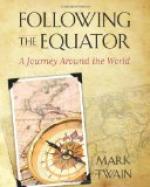Ours is a nice ship, roomy, comfortable, well-ordered, and satisfactory. Now and then we step on a rat in a hotel, but we have had no rats on shipboard lately; unless, perhaps in the Flora; we had more serious things to think of there, and did not notice. I have noticed that it is only in ships and hotels which still employ the odious Chinese gong, that you find rats. The reason would seem to be, that as a rat cannot tell the time of day by a clock, he won’t stay where he cannot find out when dinner is ready.
November 29. The doctor tells me of several old drunkards, one spiritless loafer, and several far-gone moral wrecks who have been reclaimed by the Salvation Army and have remained staunch people and hard workers these two years. Wherever one goes, these testimonials to the Army’s efficiency are forthcoming . . . . This morning we had one of those whizzing green Ballarat flies in the room, with his stunning buzz-saw noise—the swiftest creature in the world except the lightning-flash. It is a stupendous force that is stored up in that little body. If we had it in a ship in the same proportion, we could spin from Liverpool to New York in the space of an hour—the time it takes to eat luncheon. The New Zealand express train is called the Ballarat Fly . . . . Bad teeth in the colonies. A citizen told me they don’t have teeth filled, but pull them out and put in false ones, and that now and then one sees a young lady with a full set. She is fortunate. I wish I had been born with false teeth and a false liver and false carbuncles. I should get along better.
December 2. Monday. Left Napier in the Ballarat Fly the one that goes twice a week. From Napier to Hastings, twelve miles; time, fifty-five minutes—not so far short of thirteen miles an hour . . . . A perfect summer day; cool breeze, brilliant sky, rich vegetation. Two or three times during the afternoon we saw wonderfully dense and beautiful forests, tumultuously piled skyward on the broken highlands—not the customary roof-like slant of a hillside, where the trees are all the same height. The noblest of these trees were of the Kauri breed, we were told the timber that is now furnishing the wood-paving for Europe, and is the best of all wood for that purpose. Sometimes these towering upheavals of forestry were festooned and garlanded with vine-cables, and sometimes the masses of undergrowth were cocooned in another sort of vine of a delicate cobwebby texture—they call it the “supplejack,” I think. Tree ferns everywhere—a stem fifteen feet high, with a graceful chalice of fern-fronds sprouting from its top—a lovely forest ornament. And there was a ten-foot reed with a flowing suit of what looked like yellow hair hanging from its upper end. I do not know its name, but if there is such a thing as a scalp-plant, this is it. A romantic gorge, with a brook flowing in its bottom, approaching Palmerston North.




